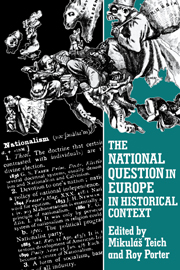Book contents
- Frontmatter
- Contents
- List of maps
- Notes on contributors
- Acknowledgements
- Introduction
- 1 The British Isles: Celt and Saxon
- 2 The making of the French nation
- 3 The national question in Italy
- 4 The roots of the national question in Spain
- 5 Shifting nationalism: Belgians, Flemings and Walloons
- 6 The nation in German history
- 7 Nationalism and nation-state in Germany
- 8 The national identity of the Austrians
- 9 The Czechs
- 10 The national question in Hungary
- 11 The union of Dalmatia with northern Croatia: a crucial question of the Croatian national integration in the nineteenth century
- 12 The national question in Poland in the twentieth century
- 13 Finland: from Napoleonic legacy to Nordic co-operation
- Index
4 - The roots of the national question in Spain
Published online by Cambridge University Press: 30 November 2009
- Frontmatter
- Contents
- List of maps
- Notes on contributors
- Acknowledgements
- Introduction
- 1 The British Isles: Celt and Saxon
- 2 The making of the French nation
- 3 The national question in Italy
- 4 The roots of the national question in Spain
- 5 Shifting nationalism: Belgians, Flemings and Walloons
- 6 The nation in German history
- 7 Nationalism and nation-state in Germany
- 8 The national identity of the Austrians
- 9 The Czechs
- 10 The national question in Hungary
- 11 The union of Dalmatia with northern Croatia: a crucial question of the Croatian national integration in the nineteenth century
- 12 The national question in Poland in the twentieth century
- 13 Finland: from Napoleonic legacy to Nordic co-operation
- Index
Summary
Writing in the fifth century the Spanish priest Orosius commented that ‘by the disposition of the land, Spain as a whole is a triangle and, surrounded as it is by the Ocean and the Tyrrhenian Sea, is almost an island’. That Nature should have endowed the Iberian Peninsula with such clearly marked boundaries has been taken by many to imply likewise that the political unity of the region was itself a natural and logical creation. But if, as Orosius noted, the boundaries of the peninsula are clear-cut, the physical landscape of the interior is far from being so. At the centre lies the vast arid tableland called the Meseta. Ringed by formidable mountain barriers, communications between this high plateau and the coastal regions of the peninsula are difficult, while the Meseta itself is bisected by a series of mountain ranges: the Sierra da Estrela, the Sierra de Gredos and the Sierra de Guadarrama. These physical divisions have endowed the peninsula with an astonishing regional diversity with the result that even if political unity has been frequently held up by some as a natural goal, Spain's ‘geographical handicap’, as Sánchez-Albornoz once referred to it, has in fact tended to encourage the development of regionalist and separatist movements.
- Type
- Chapter
- Information
- The National Question in Europe in Historical Context , pp. 106 - 127Publisher: Cambridge University PressPrint publication year: 1993
- 1
- Cited by

